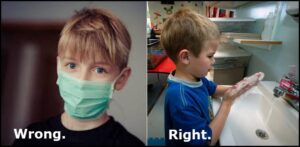Protect Yourself Against Infectious Disease: Skip the Masks – Good Old-Fashioned Hand Washing Is One of the Best Ways
 Sure, it may have been annoying the way your mom made you wash your hands so much as you were growing up. Wash after going to the bathroom, wash your hands before you eat, wash your hands after playing outside. Wash, wash, wash. And water as hot as you could stand it and plenty of soap were required. With the recent outbreak of the COVID-19 coronavirus and near panic worldwide, the focus on how to protect against an infectious disease is at the top of the list for conversations on social media, news programs, and more.
Sure, it may have been annoying the way your mom made you wash your hands so much as you were growing up. Wash after going to the bathroom, wash your hands before you eat, wash your hands after playing outside. Wash, wash, wash. And water as hot as you could stand it and plenty of soap were required. With the recent outbreak of the COVID-19 coronavirus and near panic worldwide, the focus on how to protect against an infectious disease is at the top of the list for conversations on social media, news programs, and more.
Perhaps you’ve seen photos and videos of people in China walking around out in public wearing masks over their mouths. Even here in the U.S. it’s happening, and with the prevalence of celebrities doing so, many people are rushing out to buy those disposable face masks, almost to the point of them selling out.
First, the good news. You don’t need those masks, because they really won’t keep you from getting a virus. They were designed mostly to keep someone’s cough droplets from spewing forth. The CDC and other health experts say the only ones who should be wearing those respirator masks are those who are already sick with a virus and health care workers. It gets further complicated by the fact that for those masks to be effective at all, they have to fit properly and remain in place. This morning on “Good Morning America,” Dr. Jen Ashton, their resident health expert, said she had to try five different ones to find one that fit her well.
The other thing to keep in mind is that if you’re wearing one of those masks, you have to resist the urge to lift the edge to scratch your nose. Touching your face is one of the ways that infectious diseases are spread. That mask is worthless if you’re going to touch your face underneath it. The mere act of placing your finger underneath means you’ve already contaminated the surrounding are with whatever bugs your finger is harboring, and now it’s in close proximity to your mouth and nose rather than being dispersed into the air.
And there’s more good news. Turns out Mom may have instinctively known some things. Hand washing with hot water and plain old soap is sufficient. You don’t even need anti-bacterial soap. (In fact, there is some evidence that overuse of anti-bacterial agents has actually contributed to the development of resistant organisms.) What’s the proper hand washing standard? A recent study showed that about 97% of us don’t do it right. This is what the official site of the Centers for Disease Control says:
Wet your hands with clean, running water (warm or cold), turn off the tap, and apply soap. Lather your hands by rubbing them together with the soap. Lather the backs of your hands, between your fingers, and under your nails. Scrub your hands for at least 20 seconds.
And 20 seconds may be longer than you think. Here’s a good guideline to teach your kids: Sing the ‘Happy Birthday’ song twice – that’s just about the right amount of time. (Some places recommend the ‘ABC’ song instead.)Washing should be followed up with drying, using a clean towel. Air-drying is the second best if no clean towel is available. And please don’t use those wall-mounted blower dryers; they only spread disease around in the air.
Obviously there are other guidelines for health care workers, especially doctors and nurses about to go into an operating room. And technicians who work for a biohazard and trauma cleanup company like ours have other protective protocols. But for most of us, washing our hands sufficiently with soap and running water whenever available is one of the best ways to cut down on transmission of infectious diseases.



